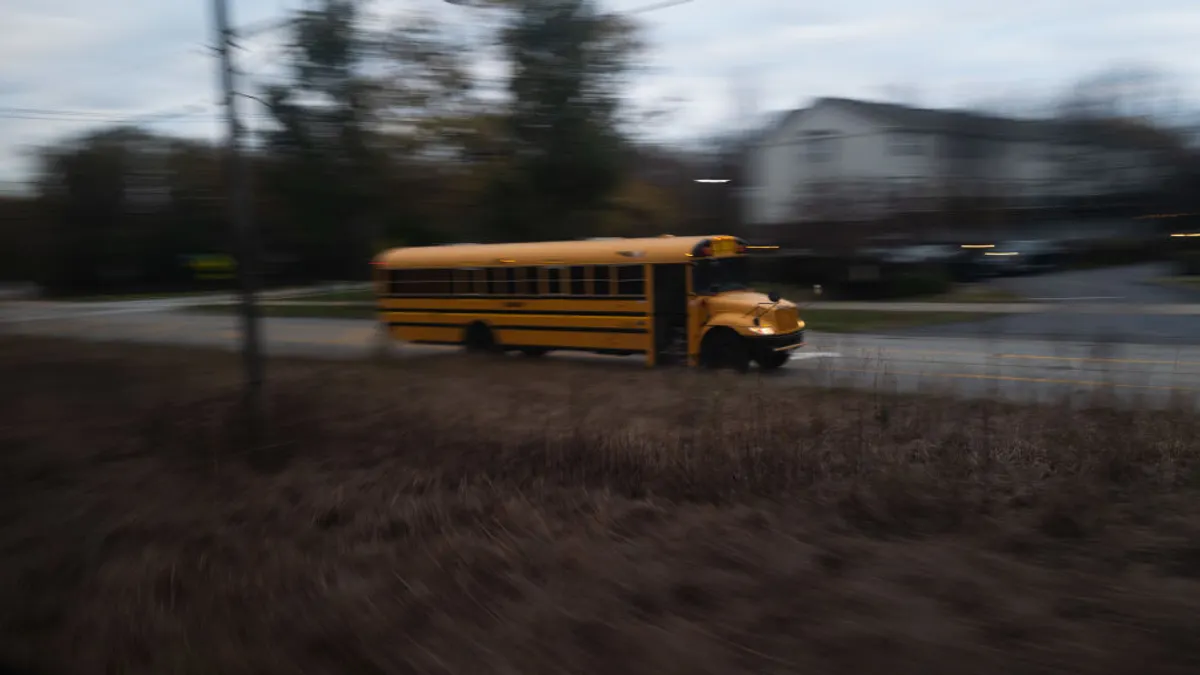Kyle Dooley will do just about anything to engage his kindergarten students in the lessons he’s teaching.
He dressed as a snowman to teach about the color white, and he sings rhyming words to emphasize word associations and reading skills. He’s also introducing “tall words” such as integrity, tenacity and empathy to encourage social and emotional well-being, especially during this challenging school year.
“I want the kids to feel safe and that I care about them,” said Dooley, who is in his first year teaching at Christopher Farms Elementary School in Virginia Beach, Virginia.
His class of 14 students started the school year virtually and then attended in-person for just over a month. But by mid-November, they were back behind screens learning from home.
Despite the disruptions, Dooley has the optimism of a first-year kindergarten teacher and the drive to make this year as fun and productive as possible for his young learners. “It was kind of cool to have two first days of school,” he said.
Early childhood educators like Dooley are reaching deep into their teacher tool kits to keep their youngest students engaged in socially distanced in-person learning environments. What’s more difficult is adapting those lessons to online formats and video conferencing. Young children can’t easily navigate online learning platforms independently. They also need adult-guided asynchronous activities so they can learn through movement and play-based activity without sitting for hours in front of a screen.
School administrators also are searching for solutions to retain the youngest learners — those in preschool and kindergarten — as well as entice families of young learners who have not yet registered their children for school.
Across the country, school systems are reporting notable decreases in K-12 enrollments this school year compared to previous years, particularly in preschool and kindergarten, which they attribute to the difficulties families are having with monitoring schooling from home for younger children and other challenges due to the pandemic.
The dips in enrollment are especially concerning to education experts because kindergarten is seen as the gateway to a formal education and a critical opportunity for providing solid foundational skills and habits for the next 12-plus years of schooling.
Educators also worry about the equity gaps that could grow between those young students having trouble accessing online learning effectively and those students whose parents are able to afford at-home tutors or private, in-school learning during the pandemic.
The enrollment and attendance declines in early elementary school is a “big concern,” said Hedy Chang, executive director and president of Attendance Works, which has monitored attendance trends before and during COVID-19 and has worked with districts to improve attendance practices. Chang, however, said there are strategies, such as data monitoring and parent communications and supports, that schools can use to boost enrollment and engagement for young students even during this public health crisis.
“Part of what we know is that if you put these in place, kids will show up,” Chang said.
Pushing for attendance waivers
In 2018, 84% of all 5-year-olds were enrolled in preschool or kindergarten, according to the National Center for Education Statistics. Kindergarten enrollment, however, is not compulsory in 31 states, research from the Education Commission of the States shows.
Texas does not require kindergarten enrollment or attendance for children who haven’t turned 6 years old by Sept. 1 of the current school year. The state is experiencing “significant drops” in preschool and kindergarten attendance, according to Curtis Culwell, executive director of Texas School Alliance, a member organization that includes 41 school districts, representing 40% of the state’s total student enrollment.
Based on data from October, there was an average 4.5% enrollment decrease in the projected number of K-12 students expected to attend schools in those 41 districts, which amounts to a loss of about 105,000 students, Culwell said.
Outreach efforts, such as home visits and deliveries of school supplies to students’ homes, have been made to encourage school participation for young children and their families, Culwell said.
“The early literacy component of this is what’s really troubling, particularly with limited English proficient [students] and kids who are educationally disadvantaged,” he said. “We worry about how to reach those kids.”
What’s also concerning is the possibility schools may need to return funding already provided by the state based on average daily attendance projections. If systems have to return funding, they may need to layoff staff or make other cuts in order to balance their budgets, Culwell said.
TSA, along with the Texas Urban Council of Superintendents, have asked the Texas Education Agency, the state education office, to waive the student attendance accounting requirements for the entire school year. TEA has already extended an average daily attendance “hold harmless” provision for funding purposes for the first two six-week attendance periods this school year. Those two attendance periods run through December or January, depending on each district's school calendar, according to Culwell.
“We have to have some latitude, particularly in attendance accounting, because the whole ball game has changed,” Culwell said.
Supporting parents
Chang, with Attendance Works, said in localities that are finding success with early learning enrollment and participation, school systems are using data to determine which families need more supports and targeted communications from schools. Proactive schools also are making early and frequent connections with families of rising preschool and kindergarten students, Chang said.
Keep Learning California, a joint project with Attendance Works, Families in Schools and the Parent Institute for Quality Education, has resources for families and educators on how to help young students maintain learning during the pandemic, as well as tips on how educators and families can work together to promote a child’s success this school year.
In Florida, Broward County Public Schools has made various efforts to support early childhood educators, young learners and families during the health crisis, said Lori Canning, executive director of Early Learning and Language Acquisition in the Fort Lauderdale district.
The system, which has the sixth-highest student population in the country, has seen a kindergarten enrollment decline by about 2,000 students, from about 14,300 to 12,300, compared to last year, Canning said.
To encourage early childhood participation and active learning this year, the district provided 2,000 pre-kindergarten backpacks full of supplies, such as foam letters, Crayons, scissors and more.
The district, which has in-person learning as well as online learning for families who chose that format, also made sure the virtual learning curriculum was developmentally appropriate by carefully planning for screen time and by providing a device for families who opted for virtual learning, said Canning. The executive director filled in as a substitute virtual teacher for one pre-kindergarten class this fall and used hands-on activities, such as scavenger hunts to teach about colors and letters.
“Part of what we know is that if you put these [supports] in place, kids will show up."

Hedy Chang
Executive director and president, Attendance Works
For educators, the district provided professional development throughout the summer to prepare for both in-person and online learning this school year, Canning said. And it created webinars for parents, teachers and administrators to share their experiences with face-to-face and e-learning. The webinars, titled Parent University, include specific sessions for early childhood and elementary education programs.
“It was very powerful to hear from the parent perspective and then from the teacher perspective,” Canning said. The district also encourages feedback from parents about what is and isn’t working well.
Boosting enrollment
East Haven Public Schools in East Haven, Connecticut, which is currently offering fulltime in-person learning and virtual learning, has actually seen an increase in kindergarten enrollment this year. Superintendent Erica Forti attributes this to the seamless preschool to kindergarten transition process the district created four years ago.
That effort included the merging of various high-quality, rigorous elements from different preschool grant programs and developing one registration process for parents. The grant programs and qualifications are explained to parents, and staff organized the grant paperwork behind the scenes — but the change made the entire preschool program feel cohesive, Forti said.
Aligning the preschool offerings also helped make the process for kindergarten transitions easier and more inviting for families, she said. Typically, families of rising kindergartners attend a school orientation in February, and in the spring, the preschool students have opportunities to meet with kindergarten teachers and tour, eat lunch and play at the schools they will attend in the fall. By the time the new school year arrives, the students and families know what to expect and are familiar with the school, Forti said.
“We wanted to make sure the foundation was very strong so we can transition the preschoolers into our kindergarten next year,” Forti said. “The transition to kindergarten is very critical.”





















